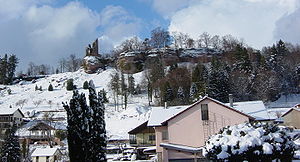
Château de Pierre-Percée
Encyclopedia
The Château de Pierre-Percée ('pierced rock castle') is a ruined castle
found in the commune
of Pierre-Percée
in the département of Meurthe-et-Moselle
, France
.
 The site in the early 12th century was in possession of Agnès, countess of Bar and widow of the count of Langenstein. She married Hermann II, Count of Salm
The site in the early 12th century was in possession of Agnès, countess of Bar and widow of the count of Langenstein. She married Hermann II, Count of Salm
and son of Hermann I, King of Germania (Eastern Francia
). A well dug 100 ft (~30 m) into the rock gives the village and the castle their name. The territory, which included the towns of Badonviller
(which became the capital of the county) and Blâmont
, became for several hundred years part of the hereditary property of the Counts of Salm. Around 1134, Hermann II went to war allied to the Duke of Lorraine against the Count of Bar and Stephan of Bar, the Bishop of Metz, himself a member of the Bar family. Hermann was killed on the battlefield outside the Château de Frouard. The castle at Pierre-Percée was besieged for a year and fell into the hands of the bishop of Metz with the death of Hermann's eldest son.
The castle was not besieged again until the Thirty Years' War
(1618-1648) when, being deserted, it was destroyed by Franco-Swedish troops.
State property, the Château de Pierre-Percée is listed as a monument historique
by the French Ministry of Culture.
This article was initially translated from part of this Wikipedia article « :fr:Pierre-Percée » , specifically from this version.
Castle
A castle is a type of fortified structure built in Europe and the Middle East during the Middle Ages by European nobility. Scholars debate the scope of the word castle, but usually consider it to be the private fortified residence of a lord or noble...
found in the commune
Communes of France
The commune is the lowest level of administrative division in the French Republic. French communes are roughly equivalent to incorporated municipalities or villages in the United States or Gemeinden in Germany...
of Pierre-Percée
Pierre-Percée
Pierre-Percée is a commune in the Meurthe-et-Moselle department in north-eastern France.-See also:*Communes of the Meurthe-et-Moselle department...
in the département of Meurthe-et-Moselle
Meurthe-et-Moselle
Meurthe-et-Moselle is a department in the Lorraine region of France, named after the Meurthe and Moselle rivers.- History :Meurthe-et-Moselle was created in 1871 at the end of the Franco-Prussian War from the parts of the former departments of Moselle and Meurthe which remained French...
, France
France
The French Republic , The French Republic , The French Republic , (commonly known as France , is a unitary semi-presidential republic in Western Europe with several overseas territories and islands located on other continents and in the Indian, Pacific, and Atlantic oceans. Metropolitan France...
.

Salm-Salm
The Principality of Salm-Salm was a state of the Holy Roman Empire. It was located in the present-day French départements of the Bas-Rhin and the Vosges and was one of a number of partitions of Salm.-History:...
and son of Hermann I, King of Germania (Eastern Francia
Eastern Francia
East Francia , also known as the Kingdom of the East Franks or Francia Orientalis, was the realm allotted to Louis the German by the 843 Treaty of Verdun...
). A well dug 100 ft (~30 m) into the rock gives the village and the castle their name. The territory, which included the towns of Badonviller
Badonviller
Badonviller is a commune in the Meurthe-et-Moselle department in north-eastern France.It has a population of 1,512.-See also:*Communes of the Meurthe-et-Moselle department*Badonviller March*Badenweiler, Germany....
(which became the capital of the county) and Blâmont
Blâmont
Blâmont is a commune in the Meurthe-et-Moselle department in north-eastern France.The Château de Blâmont is the medieval castle below which the city grew.-See also:*Communes of the Meurthe-et-Moselle department...
, became for several hundred years part of the hereditary property of the Counts of Salm. Around 1134, Hermann II went to war allied to the Duke of Lorraine against the Count of Bar and Stephan of Bar, the Bishop of Metz, himself a member of the Bar family. Hermann was killed on the battlefield outside the Château de Frouard. The castle at Pierre-Percée was besieged for a year and fell into the hands of the bishop of Metz with the death of Hermann's eldest son.
The castle was not besieged again until the Thirty Years' War
Thirty Years' War
The Thirty Years' War was fought primarily in what is now Germany, and at various points involved most countries in Europe. It was one of the most destructive conflicts in European history....
(1618-1648) when, being deserted, it was destroyed by Franco-Swedish troops.
State property, the Château de Pierre-Percée is listed as a monument historique
Monument historique
A monument historique is a National Heritage Site of France. It also refers to a state procedure in France by which national heritage protection is extended to a building or a specific part of a building, a collection of buildings, or gardens, bridges, and other structures, because of their...
by the French Ministry of Culture.
External links
This article was initially translated from part of this Wikipedia article « :fr:Pierre-Percée » , specifically from this version.

